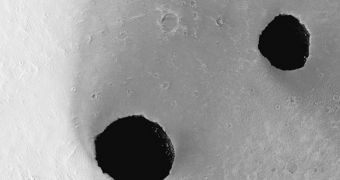New data sent back by the NASA Mars Reconnaissance Orbiter (MRO) spacecraft appear to indicate that the Red Planet features caves on its surface. The finding could have significant implications for future space exploration plans, as astronauts could squat those natural shelters.
The photographs the probe sent back show huge pits or caves puncturing and dotting the Martian surface in a dusty and bright plain located in a region adjacent to the Ascraeus Mons volcano.
MRO was capable of imaging the formations for a whole month, between October 1 and November 1, and provided its mission controllers with a large selection of photos to choose from.
In addition to the caves, the data also hint at the existence of lava tubes, canyon overhangs and other similar structures at those locations, as well as elsewhere on the surface of Mars.
All of these locations could be of tremendous use to astronauts, if we send a manned spacecraft to the Red Planet. Given the characteristics of its atmosphere,the planet cannot readily protect human life from the radiations emitted by the Sun.
But various landscape structures can easily shield any colony or traveler from ultraviolet (UV) radiation, the type that can cause significant genetic damage when falling on living cells.
Another advantage of natural caves and overhangs is that the could provide easier access to various Martian resources, such as for example ices, gases, minerals and other chemicals. Ice, for example, is essential for the success of a human mission to Mars.
Data from MRO and Mars Odyssey indicate that large volumes of water exist in icy deposits at the planet's poles, and that rivers once crisscrossed the surface of the planet. All that water went somewhere, and it would be astronauts' job to find it before settling on the planet.
The two pits that can be seen in the attached image were first seen by the Odyssey some time ago, but this view is collected with the High Resolution Imaging Science Experiment (HiRISE) instrument aboard the MRO.
This allows experts to determine that the shallower of the two pits is 590 feet (180 meters) deep, while the deeper is 1,017 feet (310 meters) deep, Daily Galaxy reports.
“When compared to the surrounding surface, the dark interiors of the holes gave off heat at night but were cool by day,” explains the principal investigator of the HiRISE camera, Alfred McEwen.
“So we then decided to target these with MRO because this thermal information may be evidence for these being caves – but the jury is still out on that,” he concludes.

 14 DAY TRIAL //
14 DAY TRIAL //